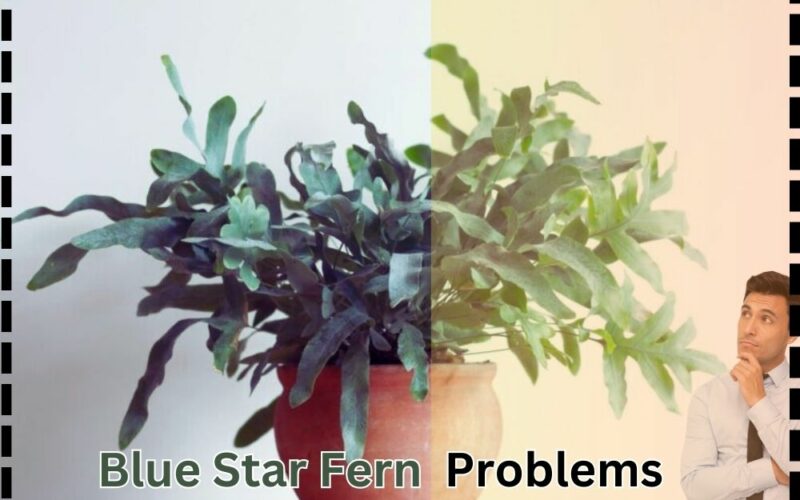I’m a plant pathologist (my academic major is plant protection) and work as a horticultural adviser. I decided to answer the most frequent questions about Blue Star Fern problems in this post. If you are concerned about your Fern, join me in here.
Blue star fern (scientific name: Phlebodium Aureum) is native to the tropical rainforest of South America and is one of today’s popular indoor plants that can thrive in warm humid conditions well. This plant is also known as Phlebodium, Phlebodium aureum Blue Star, and Blue Fern.
Anyway, most indoor gardeners have several problems caring for Blue Fern and ask me frequently about them. Hence, here, I will show you some of the most common blue star fern problems and will tell you how to both prevent and fix them.
Please note that I am walking with you during this post and you can ask your questions below this page. I will answer them as soon as possible. Let’s get going.
The Most Frequent Blue Star Fern Problems:
Here, you can find 7 common problems of Blue Star Ferns with 2 natural facts of this plant that cause some indoor gardeners to be shocked. I will show them with their images and will tell you how to resolve your blue star fern problems.
1- Why Is My Blue Star Fern Turning Brown?

Blue Star Fern brown leaves are one of the most common problems that indoor gardeners complain about. If you spot new fronds or lots get brown quickly especially on tips and edges, based on my experience it’s often due to very low humidity conditions.
Hot and dry air can intensify this situation because in low humid conditions, the soil will dry out more quickly and your Blue Star Fern will experience an under-watering problem. If the roots are exposed to dry soil, you will spot the leaves as crispy or greying. The growth of your Blue Fern will be stopped or decreased and you will see brown patches on the fronds.
Please note that due to the grey-blue appearance of your plant, you usually find out about under-watering damages very late, so keep an eye on your plant watering needs.
If you spot your Blue Star Fern is turning brown, try to keep its soil wet and moist (not soggy and waterlogged) and provide high humidity conditions. As you know lucky bamboo is another houseplant that loves to thrive in high-humidity conditions. I told you about the best ways to provide humidity for it that can be useful for Blue Star Fern too.
- ➡ Please Note that, after a year or so, the old fronds of Blue Star Fern will get brown and die. It’s common, don’t worry about it. If you take care of your plant well, it will reward you with new fresh leaves.
- ➡ If your plant is exposed the direct sunlight, you will see the symptoms of scorching as Blue Star Fern brown leaves. Your plant loves to thrive in bright indirect sunlight.
2- Blue Star Fern Brown Tips

Most people ask me why the tip of their blue star ferns is turning brown. They want to know What will cause it, how to save their Blue Fern, and how to prevent it.
As you can see in the above image, the crisping of edges and browning tips of leaves is a sign of low humidity conditions. The dry soil (under-watering conditions) will intensify these symptoms.
If the edges of the leaves are crisp with brown tips, then you likely need to increase the humidity. To prevent blue star fern brown tips:
- Provide a high-humidity environment for your plant by misting it.
- Never put it in direct sunlight.
- Avoid placing your Blue Fern near (about 4 meters) an operating radiator.
3- Why My Blue Star Fern Leaves Are Turning Black?

If your blue star fern leaves are turning black (not brown), it can be a sign of over-watering. Keep in mind roots are alive and need to breathe, never suffocate them in waterlogged soil.
The best way to avoid overwatering is to touch several inches of topsoil if you feel it dry, water your plant.
In addition, by emerging the new leaves the old ones turn black and brown. It is normal, don’t worry about it.
4- Blue Star Fern Yellow Leaves

Several factors can cause blue star fern yellow leaves including:
A: Overwatering: Based on my experiences overwatering is the most important culprit for yellowing the leaves. It will be intensified if your Blue Star Fern is placed in dim rooms or low-light places in your house.
Overwatering not only suffocate the roots but also cause the root rot. In this situation, you have to repot your plant. you must trim the infected roots and rhizomes and plant your fern in a new pot with enough drainage holes.
If you want to use pots without holes, I recommend reading my article about preventing root rot in cachepots. You must Fill your pot with well-drainage soil mixes too. By and large, you have to change your watering habits and try to keep the soil wet but not waterlogged.
B: Very Low-light places: Blue Star Ferns need a bright location with indirect sunlight. When you put them in a very low-light corner of your house, the leaves may turn yellow. If you have any problem with choosing the best place for your houseplant, I recommend reading my article about the light requirements of lucky bamboo. There, I discussed the different types of light in houses with various windows: North, South, West, and East windows.
C: Cold Temperature: the best temperature for Blue Star Fern is between 18-25 ºC (about 64-77 ºF). If it falls to 10 ºC (50ºF), the leaves will turn yellow.
D: Leaf Shine Sprays: Blue Star Fern is sensitive to these materials and if you spay them on its foliage, the leaves will turn yellow and you may see mottled spots on them. I recommend cleaning the leaves with warm distilled water.
5- Blue Star Fern Dry Leaves

If you spot wilted foliage along with the leaves of your Bleu star fern turning crispy and grey, your fern is suffering from low under-watering. Various factors can cause it:
Damaged roots: My experience showed that most people after repotting complain about “blue star fern dry leaves”. It’s due to root damage during this process and cannot absorb water as well as before repotting. I call it “Transplant shock”.
I usually recommend giving it enough time to produce new roots. You can also help your fern by providing wet soil, enough humidity, and putting it in a bright place with indirect sunlight and optimum temperature.
Under-watering: As I told you before, your Blue Star Fern thrives in wet soil (not waterlogged). Try to find out your plant water taken and watering based on its needs.
Hot and dry environments: Sometimes you may water your plant well but you spot the symptoms of drying the leaves, in this situation, you should provide a humid environment for your Lovely Fern. In Hot and Dry conditions leaves lose a lot of water and if your fern is exposed to direct sunlight its drying will be intensified.
6- What Are Tiny Bugs on My Blue Star Fern?
My experience showed that Blue Star Ferns (in fact, most of the Phlebodium species) are often resistant to most of the pests, anyway, there are reports of spotting tiny bugs on them or their soil too.
I recommend watching for mealybugs, aphids, scales, thrips, gnat fungi, spider mites, root mealybugs, and vine weevils. If you are not familiar with these pests and their symptoms, I suggest to read my article “Tiny Bugs on houseplants”. It will help you to gain an overview of them and their damages.
If you have any problem with these pests, spraying with Neem oil can be a well DIY homemade remedy to get rid of them.
7- Why My Blue Star Fern Is Dying?
One of the common questions the people often ask me is about blue star fern dying. Several agents can cause it and you must tell me about the symptoms. For example, the leaves are turning black or yellow.
All of the above Blue Star Fern problems can cause it to die if you don’t fix them immediately. If you spot other symptoms that I didn’t mention in this post, you can send their images to me (inhouseplant2017@gmail.com), please inform me below this page too. I will help you as soon as possible.
Two Natural Facts about Blue Star Ferns
Most new gardeners ask me about the Blue Star Fern’s fuzzy roots and White Spots on its leaves. They are natural things on your fern. Don’t worry about them. I discuss these phenomena in the following so keep reading.
1- Are Blue Star Fern Fuzzy Roots Normal?

It is one of the frequent questions that new gardeners ask me. The Blue star fern fuzzy roots are indeed its rhizomes that you spot as fuzzy orange rhizomes at the base of the plant. You can use them for propagating your fern.
2- What Are White Spots on My Blue Star Fern?

Your fern propagates by producing spores behind its fronds. They are visible dark brown spots as you can see in the picture. Indeed, they are mature spores and before your Blue Star Fern produces them, you see white spots or bumps on its fronds.
Some people mistake these notable white spots for pests or diseases, if you cannot distinguish between them, take a clear and close picture and send me (please inform me below this page to find your email quickly).
Conclusion
I tried to answer most of the concerns of indoor gardeners about Blue Star Fern problems. Was this post helpful for you? if you didn’t find your Blue Star Fern problem here, I can help you if you tell me about it below this page.
You can improve this post by sending the images of your Fern problems to me and writing about them here. thank you.

Elahe Rabiei
Hi, I’m Elaheh. My Academic major is plant protection, and houseplants are my expertise. As a houseplant lover, my house is full of indoor plants and it is my passion to take care of them. Hence, I’m here to share my knowledge and experience about growing healthy houseplants. I am also a plant protection advisor, so feel free to ask me any questions you may have.


When I repot my blue star fern, should I try to keep the rhizomes on the surface? They have embedded themselves in the soil!!
Hi Callie,
thanks for your question and Its very important question about repotting Blue Ferns.
Yes, you should try to keep the rhizomes of your blue star fern on the surface when repotting.
These creeping, scaly structures are essential for the plant’s growth and development. Burying them can hinder their function and potentially damage the fern.
Here’s what you can do:
Gently loosen the soil: Carefully remove the fern from its pot and gently loosen the soil around the rhizomes.
Place in the new pot: Position the fern in its new pot, ensuring that the rhizomes are on top of the soil.
Add fresh potting mix: Fill in around the roots with fresh, well-draining potting mix. Make sure the rhizomes remain exposed.
please note that your Blue star ferns prefer slightly pot-bound conditions, so don’t go for a pot that’s much larger than the current one.
please feel free to ask me your questions.
Good luck